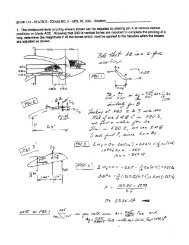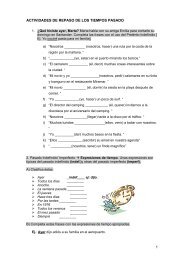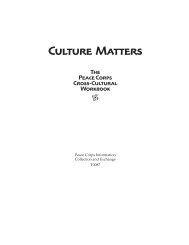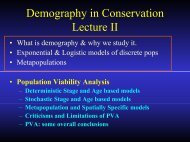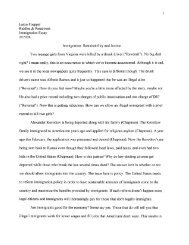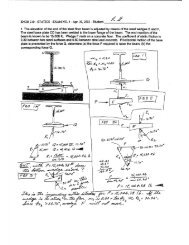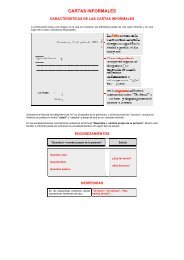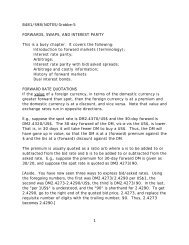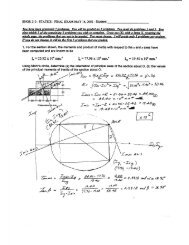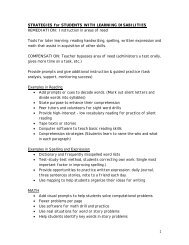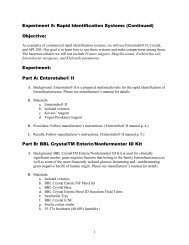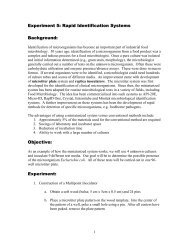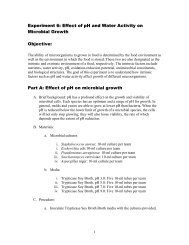Chapter 12 Questions 1. Which of the following is true of the ...
Chapter 12 Questions 1. Which of the following is true of the ...
Chapter 12 Questions 1. Which of the following is true of the ...
- No tags were found...
Create successful ePaper yourself
Turn your PDF publications into a flip-book with our unique Google optimized e-Paper software.
<strong>Chapter</strong> <strong>12</strong> <strong>Questions</strong><strong>1.</strong> <strong>Which</strong> <strong>of</strong> <strong>the</strong> <strong>following</strong> <strong>is</strong> <strong>true</strong> <strong>of</strong> <strong>the</strong> influenza virus?A) Transm<strong>is</strong>sion usually occurs by water contamination.B) The virion has no protein associated with it.C) Replication <strong>of</strong> <strong>the</strong> virion takes place in <strong>the</strong> body's kidney cells.D) The virion undergoes antigenic variations.E) The virion has no envelope.2. The respiratory syncytial virus takes its name from <strong>the</strong>A) formation <strong>of</strong> giant cells in t<strong>is</strong>sue culture cells.B) involvement <strong>of</strong> <strong>the</strong> liver t<strong>is</strong>sue.C) lys<strong>is</strong> <strong>of</strong> <strong>the</strong> red blood cells which accompanies <strong>the</strong> d<strong>is</strong>ease.D) type <strong>of</strong> mammal in which <strong>the</strong> d<strong>is</strong>ease <strong>is</strong> usually located.E) involvement <strong>of</strong> <strong>the</strong> nervous system.3. Guillain-Barre syndrome and Reye syndrome are bothA) accompanied by massive amounts <strong>of</strong> virus in <strong>the</strong> brain t<strong>is</strong>sueB) associated with influenza viruses.C) due to adenoviruses.D) transmitted chiefly by female mosquitoes.E) viral d<strong>is</strong>eases <strong>of</strong> <strong>the</strong> skin.4. <strong>Which</strong> <strong>of</strong> <strong>the</strong> <strong>following</strong> applies to <strong>the</strong> adenovirusesA) one type causes an eye inflammation called keratoconjunctivit<strong>is</strong>.B) The viruses are involved in liver d<strong>is</strong>eases.C) Most adenoviruses are transmitted by contaminated arthropods.D) The viruses have a close association with Reye syndrome.E) Most adenoviruses are composed <strong>of</strong> RNA.5. The fifth d<strong>is</strong>ease <strong>is</strong> accompanied byA) substantial lesion formation in <strong>the</strong> brain t<strong>is</strong>sue and meninges.B) infection <strong>of</strong> <strong>the</strong> kidneys and an interruption <strong>of</strong> urine production.C) a fiery red rash on <strong>the</strong> cheeks and ears resembling a slap.D) yellowing <strong>of</strong> <strong>the</strong> skin resulting from seepage <strong>of</strong> bile form <strong>the</strong> liver.E) fluid-filled skin bl<strong>is</strong>ters.6. The fluid-filled vesicles occurring in cases <strong>of</strong> chickenpoxA) contain large amounts <strong>of</strong> virus.B) are similar to those in syphil<strong>is</strong>.C) break out simultaneously over <strong>the</strong> whole body.D) contain very few viruses.E) reflect infection <strong>of</strong> <strong>the</strong> cerebrospinal fluid.Page 1
7. All <strong>the</strong> <strong>following</strong> are considered forms <strong>of</strong> herpes simplex exceptA) cold sores forming around <strong>the</strong> lips and nose.B) herpes encephalit<strong>is</strong>, a brain d<strong>is</strong>ease that may occur in newborns.C) genital herpes.D) liver damage developing in young adults.E) gingivostomatit<strong>is</strong>.8. The TORCH d<strong>is</strong>eases are those thatA) are associated with high fever syndromes.B) pass from a pregnant woman to <strong>the</strong> developing fetus.C) occur only in topically-related cellular h<strong>is</strong>tiocytes.D) can be treated with antibiotics.E) cause <strong>the</strong> body to burn with fever.9. All <strong>the</strong> <strong>following</strong> may be associated with measles exceptA) Koplik spots.B) a rare brain d<strong>is</strong>ease called subacute sclerosing panencephalit<strong>is</strong>.C) a red skin rash.D) inflammation <strong>of</strong> <strong>the</strong> salivary glands.E) sensitivity to light.10. Orchit<strong>is</strong> <strong>is</strong> a d<strong>is</strong>ease that may develop inA) children who have had influenza.B) adult males who have had mumps.C) animals who contract smallpox.D) pre-pubescent females who contract German measles.E) children who have had Kawasaki d<strong>is</strong>ease.1<strong>1.</strong> One <strong>of</strong> <strong>the</strong> reasons for <strong>the</strong> success <strong>of</strong> <strong>the</strong> smallpox eradication campaign was thatA) smallpox could be treated with antibiotics.B) smallpox viruses were used in <strong>the</strong> vaccine.C) smallpox occurred only in humans.D) smallpox was not a transm<strong>is</strong>sible d<strong>is</strong>ease.E) smallpox occurred only in South America.<strong>12</strong>. German measles <strong>is</strong> similar to measles becauseA) both d<strong>is</strong>eases are caused by <strong>the</strong> same virus.B) <strong>the</strong> gastrointestinal tract <strong>is</strong> involved in both d<strong>is</strong>eases.C) a skin rash occurs in both d<strong>is</strong>eases.D) both d<strong>is</strong>eases lead to Reye syndrome.E) both d<strong>is</strong>eases affect <strong>the</strong> reproductive organs.Page 2
13. Herpes zoster, or shingles, <strong>is</strong> an adult d<strong>is</strong>ease caused byA) an RNA virus with spikes.B) an RNA virus without spikes.C) <strong>the</strong> rubeola virus.D) a virus transmitted mainly by arthropods.E) <strong>the</strong> same virus that causes chickenpox.14. All <strong>the</strong> <strong>following</strong> may be observed in an individual who has rubella exceptA) occasional fever.B) deep yellowing <strong>of</strong> <strong>the</strong> skin.C) variable, pale pink maculopapular rash.D) swollen lymph nodes.E) mild cold symptoms.15. The MMR immunization program has significantly affected <strong>the</strong> annual incidence <strong>of</strong> all<strong>the</strong> <strong>following</strong> d<strong>is</strong>eases exceptA) rubella.B) German measles.C) mumps.D) measles.E) chickenpox.16. All <strong>the</strong> <strong>following</strong> conditions can be associated with congenital rubella syndrome exceptA) deafness.B) cataracts.C) difficulty in seeing.D) heart defects.E) encephalit<strong>is</strong>.17. Most cases <strong>of</strong> herpes zoster, or shingles, occur inA) pre-pubescent males.B) females who have undergone a hysterectomy.C) individuals treated with measles gamma globulin.D) people over 50 years <strong>of</strong> age.E) females who have had contact with mumps viruses.18. Diagnos<strong>is</strong> <strong>of</strong> <strong>the</strong> fifth d<strong>is</strong>ease <strong>is</strong> <strong>of</strong>ten based onA) <strong>the</strong> hemagglutination-inhibition test.B) observation <strong>of</strong> character<strong>is</strong>tic symptoms.C) <strong>is</strong>olation <strong>of</strong> <strong>the</strong> responsible virus.D) character<strong>is</strong>tic damage to <strong>the</strong> liver.E) swelling <strong>of</strong> <strong>the</strong> salivary glands.Page 3
19. A large, brick-shaped DNA virion <strong>is</strong> <strong>the</strong> responsible agent <strong>of</strong>A) smallpox.B) Reye syndrome in recoverers from influenza.C) chickenpox.D) subacute sclerosing panencephalit<strong>is</strong>.E) Kawasaki d<strong>is</strong>ease.20. <strong>Which</strong> <strong>of</strong> <strong>the</strong> <strong>following</strong> <strong>is</strong> a character<strong>is</strong>tic sign <strong>of</strong> Kawasaki d<strong>is</strong>ease?A) macules that progress to papules <strong>the</strong>n vesiclesB) a "slapped cheek" appearance on <strong>the</strong> faceC) peeling <strong>of</strong> <strong>the</strong> skin about <strong>the</strong> fingersD) loss <strong>of</strong> nervous function and decreased intellectual skillsE) crops <strong>of</strong> fluid-filled vesicles2<strong>1.</strong> The prospects for developing a vaccine for <strong>the</strong> common cold are not prom<strong>is</strong>ing becauseA) <strong>the</strong> common cold virus has not been identified.B) many different viruses can cause <strong>the</strong> common cold.C) funds for th<strong>is</strong> type <strong>of</strong> research are not available.D) <strong>the</strong>re would be virtually no candidates for such a vaccine.E) viruses cannot be cultivated in t<strong>is</strong>sue culture medium.22. Studies performed in <strong>the</strong> 1980s suggested a link betweenA) measles and orchit<strong>is</strong> in men.B) Kawasaki d<strong>is</strong>ease and genital warts.C) ethylene oxide and relief from influenza.D) rhinoviruses and diarrhea.E) aspirin and Reye syndrome.23. The global eradication campaign for <strong>the</strong> elimination <strong>of</strong> smallpoxA) depended upon <strong>the</strong> elimination <strong>of</strong> arthropod vectors.B) was completed in <strong>the</strong> 1970s.C) failed m<strong>is</strong>erably due to insufficient resources.D) required that all involved health workers receive <strong>the</strong> MMR immunization.E) was led by Edward Jenner.24. Firm, waxy, elevated lesions with a depressed center and appearing white or pink andexpressing a milky, curdlike substance characterizeA) <strong>the</strong> lesions <strong>of</strong> herpes simplex.B) Koplik spots.C) <strong>the</strong> symptoms <strong>of</strong> fifth d<strong>is</strong>ease.D) molluscum contagiosum.E) <strong>the</strong> lesions <strong>of</strong> chickenpox.Page 4
25. All <strong>the</strong> <strong>following</strong> character<strong>is</strong>tics apply to <strong>the</strong> rhinoviruses exceptA) <strong>the</strong>y are DNA viruses with helical symmetry.B) <strong>the</strong>y belong to <strong>the</strong> Picornaviridae family <strong>of</strong> viruses.C) <strong>the</strong>y take <strong>the</strong>ir name from <strong>the</strong> Greek rhinos meaning nose.D) <strong>the</strong>y can cause head colds.E) <strong>the</strong>y can be transmitted by hand-to-hand contact.26. The scientific name for measles <strong>is</strong>A) rubella.B) variola.C) varicella.D) rubeola.27. Viruses that have spikes on <strong>the</strong>ir envelopes and contain both hemagglutinin andneuraminidase causeA) chickenpox.B) influenza.C) smallpox.D) <strong>the</strong> common cold.28. A respiratory d<strong>is</strong>ease which affects young children takes its name from <strong>the</strong> giant cells thatform from <strong>the</strong> fusion <strong>of</strong> infected culture cells. These giant cells are calledA) syncytia.B) Lipshutz bodies.C) Koplik spots.D) zoster cells.29. Even though a virus that causes th<strong>is</strong> d<strong>is</strong>ease has not yet been <strong>is</strong>olated, <strong>the</strong> course <strong>of</strong> <strong>the</strong>d<strong>is</strong>ease <strong>is</strong> suggestive <strong>of</strong> a viral agent. Th<strong>is</strong> d<strong>is</strong>ease <strong>is</strong>A) rubella.B) rubeola.C) molluscum contagiosum.D) Kawasaki d<strong>is</strong>ease.30. In adults, mumps virus represents a threat to <strong>the</strong> reproductive organs. In males, infection<strong>of</strong> <strong>the</strong> testes with mumps virus <strong>is</strong> calledA) oophorit<strong>is</strong>.B) papules.C) orchit<strong>is</strong>.D) pustules.Page 5
3<strong>1.</strong> When adenovirus multiplies in <strong>the</strong> nucleus <strong>of</strong> an infected cell, itA) produces skin lesions called vesicles.B) causes v<strong>is</strong>ible nuclear granules called inclusions.C) induces nuclear changes called fomites.D) forms Koplik spots.32. Each <strong>of</strong> <strong>the</strong> <strong>following</strong> d<strong>is</strong>eases <strong>is</strong> caused by a member <strong>of</strong> <strong>the</strong> herpesviridae, exceptA) chickenpox.B) shingles.C) smallpox.D) cold sores.33. A drug thought to inhibit viral d<strong>is</strong>ease because it <strong>is</strong> a base analog substitute <strong>is</strong>A) acyclovir.B) ZIG.C) amantadine.D) TORCH.34. A virus closely related to <strong>the</strong> smallpox virus causesA) chickenpox.B) cold sores.C) molluscum contagiosum.D) mumps.35. All <strong>of</strong> <strong>the</strong> <strong>following</strong> statements are associated with parainfluenza except:A) <strong>the</strong> parainfluenza virus <strong>is</strong> an RNA virusB) th<strong>is</strong> <strong>is</strong> a d<strong>is</strong>ease associated with summer wea<strong>the</strong>rC) parainfluenza <strong>is</strong> generally a milder d<strong>is</strong>ease than influenzaD) parainfluenza <strong>is</strong> most <strong>of</strong>ten seen in children under <strong>the</strong> age <strong>of</strong> 636. Select one <strong>of</strong> <strong>the</strong> <strong>following</strong> four choices for each <strong>of</strong> <strong>the</strong> d<strong>is</strong>eases below:______accompanied by oral red patches called Koplik spots______viruses undergo antigenic variation______caused by <strong>the</strong> same virus that causes shingles______cold sores, encephalit<strong>is</strong> or genital infections______immunization with <strong>the</strong> MMR vaccine______may be transmitted by sexual contact______sometimes complicated by Reye's syndrome or GBS______also known as varicellaPage 6
______vaccine in common use has substantially reduced incidence______body rash somewhat similar to <strong>the</strong> scarlet fever rash______accompanied by fluid-filled, teardrop-shaped skin lesions______one <strong>of</strong> <strong>the</strong> TORCH group <strong>of</strong> d<strong>is</strong>eases______cesarean birth <strong>is</strong> necessary if diagnosed in a pregnant woman______viral spikes contain neuraminidase and hemagglutinin.______active cases can be treated with amantadine______acyclovir used to lessen symptoms______also known as rubeola______occurs in types A, B and C______recurring bl<strong>is</strong>ters in response to stresses______secondary bacterial d<strong>is</strong>ease may occura. herpes simplexb. influenzac. measlesd. chickenpox37. Match each word or phrase with its correct character<strong>is</strong>tic.______TORCH______neuraminidase______keratoconjunctivit<strong>is</strong>______syncytia______parvovirus______macule______vesicle______variolation______spike______rhinovirus______rubella______measles______herpes zoster______neonatal herpes______croup______SSPE______MMR______Kawasaki syndrome______warts______VZIG______GBS______H spikea. inflammation <strong>of</strong> corneab. d<strong>is</strong>eases which may be congenitally acquiredPage 7
c. giant cell that are fusedd. enzyme; ass<strong>is</strong>ts virus to enter/exit celle. may cause fifth d<strong>is</strong>easef. sac containing fluid or gasg. projection on viral envelopeh. d<strong>is</strong>colored or pink spot on skini. major cause <strong>of</strong> common coldj. immunization against smallpoxk. laryngit<strong>is</strong>, hoarse cough, and difficult breathingl. RNA virus; causes Koplik spots and feverm. RNA virus; causes mild symptoms in adults and fetal fatalitiesn. encephalit<strong>is</strong> in newborn infantso. causes chickenpox and shinglesp. viral cause not identified; fever, sore throat, and red spots, peeling skin on fingersq. enzyme; on viral enveloper. vaccine which protects against three viral d<strong>is</strong>easess. benign skin growthst. rare brain d<strong>is</strong>easeu. condition <strong>of</strong> nerve damage, paralys<strong>is</strong>, and comav. protective globulins38. The MMR vaccine provides immunization to measles, molluscum contagiosum andrubeola.A) TrueB) False39. Evidence suggests that Reye syndrome and Guillain-Barre syndrome may both betriggered by influenza viruses.A) TrueB) False40. The respiratory syncytial virus takes its name from syncytia, <strong>the</strong> giant cells that formfrom <strong>the</strong> fusion <strong>of</strong> infected culture cells.A) TrueB) False4<strong>1.</strong> Adenoviruses cause an intestinal d<strong>is</strong>ease characterized by <strong>the</strong> output <strong>of</strong> large amounts <strong>of</strong>water in <strong>the</strong> unrelenting diarrhea.A) TrueB) FalsePage 8
42. There are only three variants <strong>of</strong> rhinoviruses, which <strong>is</strong> why a vaccine for <strong>the</strong> commonhead cold <strong>is</strong> a real possibility in <strong>the</strong> future.A) TrueB) False43. Warts are small, usually benign skin growths that are commonly due to viruses.A) TrueB) False44. Immunization to smallpox may be rendered by injecting a preparation <strong>of</strong> cowpox viruses,as first demonstrated by Edward Jenner.A) TrueB) False45. The causative agent <strong>of</strong> measles has thus far eluded microbiolog<strong>is</strong>ts.A) TrueB) False46. The mumps virus <strong>is</strong> widespread in nature and may be contracted by contact with one's petor by consumption <strong>of</strong> contaminated water.A) TrueB) False47. Kawasaki d<strong>is</strong>ease <strong>is</strong> so similar to mumps in viral cause and symptoms that <strong>the</strong> twod<strong>is</strong>eases are <strong>of</strong>ten m<strong>is</strong>taken.A) TrueB) False48. The character<strong>is</strong>tic signs <strong>of</strong> molluscum contagiosum are firm, waxy, wart-like lesionswhich yield a milky substance when depressed.A) TrueB) False49. Genital herpes <strong>is</strong> a d<strong>is</strong>ease which only occurs once in a person's lifetime and for whichimmunization <strong>is</strong> available with a vaccine.A) TrueB) FalsePage 9
50. The measles rash begins on <strong>the</strong> hands and feet, <strong>the</strong>n spreads to <strong>the</strong> body trunk where it <strong>is</strong>maculopapular.A) TrueB) False5<strong>1.</strong> Rubeola <strong>is</strong> a dangerous d<strong>is</strong>ease in pregnant women because <strong>the</strong> viruses localize on <strong>the</strong>placenta and pass across <strong>the</strong> umbilical cord to infect <strong>the</strong> fetus.A) TrueB) False52. The fifth d<strong>is</strong>ease, also known as ery<strong>the</strong>ma infectiosum, affects children primarily.A) TrueB) False53. An attack <strong>of</strong> mumps, whe<strong>the</strong>r in one gland or both, generally yields permanent immunity.A) TrueB) False54. Having a mild form <strong>of</strong> smallpox would not necessarily immunize an individual against<strong>the</strong> d<strong>is</strong>ease if <strong>the</strong> serious form came along later.A) TrueB) False55. At th<strong>is</strong> writing, approximately 2000 cases <strong>of</strong> smallpox occur in <strong>the</strong> world annually.A) TrueB) False56. Children one to two years <strong>of</strong> age account for most victims <strong>of</strong> Kawasaki d<strong>is</strong>ease.A) TrueB) False57. Among <strong>the</strong> major causes <strong>of</strong> warts in humans are <strong>the</strong> papova viruses, a group <strong>of</strong> helical,RNA virions.A) TrueB) False58. Adenoviruses have been associated with gene <strong>the</strong>rapy experiments.A) TrueB) FalsePage 10
59. In adults, fifth d<strong>is</strong>ease causes symptoms similar to rheumatoid arthrit<strong>is</strong>.A) TrueB) False60. Certain groups <strong>of</strong> viruses cause numerous d<strong>is</strong>eases in humans. Describe <strong>the</strong> variousd<strong>is</strong>eases that may be due to adenoviruses, herpesviruses and poxviruses.6<strong>1.</strong> Explain <strong>the</strong> relationship between:chickenpox and herpes zostermumps and orchit<strong>is</strong>influenza and Reye syndrome62. Outline several factors and describe <strong>the</strong> efforts that have contributed to <strong>the</strong> elimination <strong>of</strong>smallpox from <strong>the</strong> world.63. D<strong>is</strong>cuss <strong>the</strong> possible repercussions if genital herpes or rubella were contracted by apregnant woman.64. Describe <strong>the</strong> immunization methods and materials available for protection againstsmallpox, measles, mumps and rubella. Explain why immunizations for chickenpox,genital herpes and influenza are not available as yet.65. Explain <strong>the</strong> meaning <strong>of</strong> each <strong>of</strong> <strong>the</strong> <strong>following</strong> terms:neuraminidaseacyclovirsyncytiaTORCHdesquammationKoplik spotsvesiclepockV2IGmolluscum body66. Describe <strong>the</strong> salient differences in <strong>the</strong> skin rashes that occur in cases <strong>of</strong> measles, fifthd<strong>is</strong>ease, smallpox and Kawasaki d<strong>is</strong>ease.Page 11
67. Explain <strong>the</strong> origin <strong>of</strong> <strong>the</strong> names for <strong>the</strong> <strong>following</strong> d<strong>is</strong>eases:respiratory syncytial virus d<strong>is</strong>easemumpsfifth d<strong>is</strong>easeKawasaki d<strong>is</strong>easemolluscum contagiosumchickenpox68. Write a paragraph on influenza explaining <strong>the</strong> character<strong>is</strong>tics <strong>of</strong> <strong>the</strong> virus, <strong>the</strong> symptoms<strong>of</strong> d<strong>is</strong>ease, <strong>the</strong> methods for treatment and immunization and <strong>the</strong> complications that candevelop from <strong>the</strong> d<strong>is</strong>ease.69. Describe <strong>the</strong> important symptoms that d<strong>is</strong>tingu<strong>is</strong>h cases <strong>of</strong> Kawasaki d<strong>is</strong>ease, molluscumcontagiosum, chickenpox and mumps.Page <strong>12</strong>
Answer Key -- <strong>Chapter</strong> <strong>12</strong><strong>1.</strong> D2. A3. B4. A5. C6. A7. D8. B9. D10. B1<strong>1.</strong> C<strong>12</strong>. C13. E14. B15. E16. E17. D18. B19. A20. C2<strong>1.</strong> B22. E23. B24. D25. A26. D27. B28. A29. D30. C3<strong>1.</strong> B32. C33. A34. C35. B36. c,b,d,a,c,a,b,d,c,c,d,a,a,b,b,a,c,b,a,b37. b,d,a,c,e,h,f,j,g,i,m,l,o,n,k,t,r,p,s,v,u,q38. B39. A40. A4<strong>1.</strong> B42. B43. A44. APage 13
45. B46. B47. B48. A49. B50. B5<strong>1.</strong> B52. A53. A54. B55. B56. A57. B58. A59. A60. (No answer.)6<strong>1.</strong> (No answer.)62. (No answer.)63. (No answer.)64. (No answer.)65. (No answer.)66. (No answer.)67. (No answer.)68. (No answer.)69. (No answer.)Page 14



